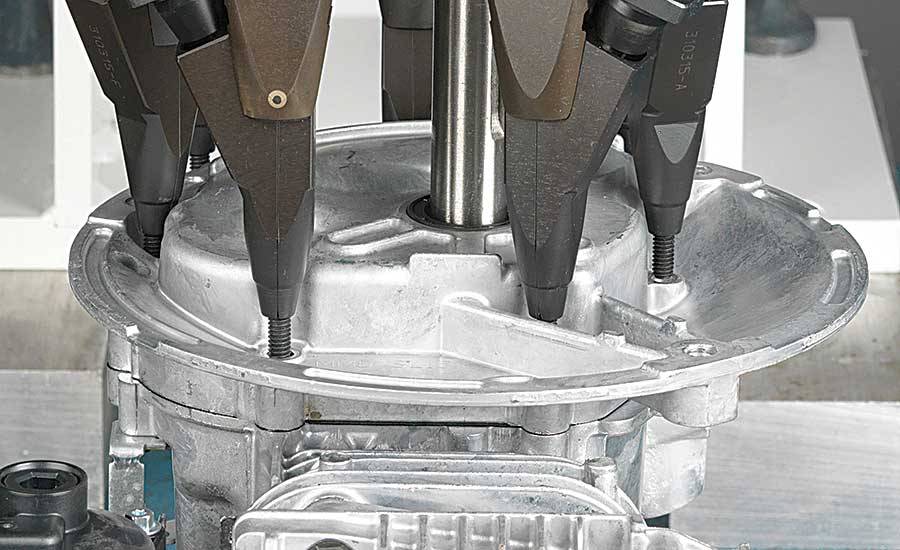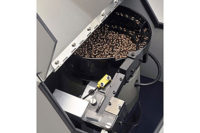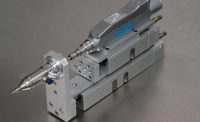The biggest challenge in automatic screwdriving isn't speed or torque accuracy: It's getting the fastener to the tool reliably and oriented correctly.
With an electric screech and a puff of smoke, my aging home computer finally died last year. Maybe I'd seen too many episodes of CSI, but on a whim, I decided to disassemble the hard drive.
Though the device was no larger than a paperback, I was amazed to discover that it contained more than 60 screws! The longest was 3/4 inch; the shortest 3/32 inch. I counted three drive styles, two finishes and multiple head sizes, thread sizes and thread forms. There were even a couple of SEMS. The most of any one type of fastener was six.
Looking at the array of parts on my workbench, I realized that most, if not all, of those fasteners must have been installed with some form of automation. The volumes are just too high. Seagate Technology, one of the largest manufacturers of hard drives, assembled more than 80 million of the devices last year alone. If each of those drives contain only half the number of fasteners in my old drive, that amounts to more than 6 million screws per day. And, most of those would be less than 3/8 inch long.
"If you install 2,000 to 2,500 screws per day, you can justify automation," says Vic Glenn, president of Design Tool Inc. "But, I've seen it justified at lower volumes for ergonomic reasons. Rolling screws around in your hand puts you at greater risk for carpal tunnel syndrome than actually running the tool."
Jarrod Neff, marketing manager at Visumatic Industrial Products, says assemblers can typically save $0.05 per fastener by switching from a manual screwfeeding process to an automated one. They can save even more if the fasteners are small and hard to handle.
"In the past 2 years, we've seen an influx of people coming to us with really small screws-#000 screws, for example-that are going into medical and electronics applications," he says. "I can't believe they even make screws that small. Operators can't pick them up. They can't orient them. They can't put them on a bit. They can't control them to get them into the part. If you can get tooling to help them with that process, it's a slam dunk."
Low-Tech Methods
Assemblers of more mundane products than disk drives need not have production volumes measured in the millions in order to justify automation. Indeed, some inexpensive and decidedly low-tech equipment can significantly boost efficiency on the assembly line.
A screwdriving system developed by Bosch Production Tools is a good example. The system consists of a small, handheld pneumatic screwdriver and a perforated metal sorting sheet. The operator places a handful of screws on the sheet and then gently shakes it until the shanks of all the screws drop into the slots. Sheets are available for three screw sizes: M1.6-M2, M2.5 and M3.
The driver, which weighs less than 8 ounces, can be equipped with an optional fastener retaining system that creates a vacuum at the tip of the bit. Instead of fumbling with fingers inside a bin, the operator uses the driver to pick up a screw from the sorting sheet. The vacuum holds the screw in place.
The vacuum is generated by the air used to power the tool, and the vacuum level is adjustable. When vacuum is desired, a guide sleeve and holding spring are slid over the bit. The guide sleeve is supplied unfinished. The bore of the sleeve is drilled, but the tip must be machined to fit each screw application. The spring allows the sleeve to retract into the tool as the screw is fastened. Bits are available for slotted, Phillips, Pozidrive and Torx screws.
When the screwdriver is not in use, it can be placed into an optional holding fixture, which is attached to a valve that shuts off air to the tool. This saves energy and prevents dirt from clogging the tool. The driver is certified for use in clean rooms and does not require lubricating oil for the air motor. The tool's torque range is 0.06 to 1 newton-meter.
Another low-tech option for screwfeeding is the screw presenter. Loose screws are loaded into a hopper, and a mechanism presents individual screws-head up, shank down-to an operator or a desktop Cartesian robot. As with the screw sorting sheet, the bit of the screwdriver is used to pick up one screw at a time from the machine. A vacuum or a magnetic bit holds the screw in place for installation.
"A screw presenter is a good first step in automating your process," says Ken Maio, business development manager at AIMCO. "It's reasonably priced. You get good value for your automation dollar. It's also flexible. Most of the good ones have interchangeable tracks, so you can quickly change from one screw size to another. [In contrast] a bowl feeder is typically dedicated to a single screw."
The specifications of screw presenters vary, but AIMCO's Acrafeed screw presenter is typical. It feeds #0 to #10 screws with a maximum length of 3/4 inch. The hopper holds 1,200 #4 screws.
Screw presenters don't have to be self-contained systems. Instead, a screw presenter mechanism can be attached to the output of a vibratory bowl. To increase the speed of the operation, these mechanisms are tooled to help the operator guide the screwdriver to the pick point.
High-Tech Methods
For higher volume applications, a blow-feeding system is necessary. These systems have four main parts:
- a device for orienting and singulating bulk fasteners,
- an escapement,
- a feeding tube,
- tooling at the end of the driver to catch the blown fastener and present it to the bit.
The driver itself can be pneumatic or electric. And, although the driver does not necessarily have to be supplied by the same company that designs the feed system, most assemblers prefer to acquire both the tool and the feeder as a complete system.
There are several options for orienting and singulating bulk fasteners, but by far, the most common is the vibratory bowl. A spiral track climbs up from the bottom of the bowl along the inside wall. As the bowl vibrates, the screws literally jump their way up the track. Tooling at the top of the track captures, orients and aligns the screws for the escapement. Misoriented screws fall to the bottom of the bowl.
Made from steel or plastic, vibratory bowls are usually custom-built for specific fasteners. However, this doesn't mean that bowls can't be flexible, says Boris Baeumler, vice president of technology at Deprag Inc. In some cases, for example, a bowl can be built with two spiral tracks, instead of one. Each spiral would end at opposite sides of the bowl.
"With a one feed hose to the left and one to the right, you can supply two operators, totally independent of each other, from the same bowl," says Baeumler.
Alternatively, a bowl with twin spirals can be used to feed two different fasteners. Each spiral would be dedicated to one fastener. "To switch from one fastener to the other, you empty the bowl of fasteners, block the first track, open the second, and refill the bowl with the other fastener," says Baeumler. "This isn't something you'd want to do every 15 minutes, but it does give you some flexibility."
For optimal feeding, the amount of screws inside the bowl should be kept at a relatively constant level, advises Baeumler. As a result, in high-volume applications, it's often a good idea to use a hopper to keep the bowl supplied with screws.
Drum feeders are another option for singulating bulk fasteners. The drum is oriented like a waterwheel. As it rotates, vanes inside the drum capture fasteners. When the fasteners reach the top of the drum's arc, correctly oriented screws fall into a track and head for the escapement, while misoriented screws fall to the bottom of the drum.
"Drum feeders handle screws more gently than a vibratory bowl," says Maio.
A third option for singulating bulk fasteners is the sword feeder. Protruding from the bottom of a wedge-shaped rectangular hopper is a blade with a slot cut into it. As the blade rises on an angle through the hopper, fasteners fall into the slot, shank first, and slide down to the escapement.
Because of its gentle action, the sword feeder is good for coated fasteners or screws made from sensitive materials. It's also quieter than vibratory bowls and drum feeders. "You can run the sword feeder until it's completely empty," says Baeumler. "Normally, you have to refill a vibratory feeder bowl before it's empty, so it's possible that a fastener could be in the bowl for days or weeks." Subjected to constant rubbing and vibration, the fastener could become unusable.
The sword feeder can accept fasteners with a maximum head diameter of 12 millimeters and a maximum shaft length of 25 millimeters. The hopper has a capacity of 1.5 liters.
Escapements, Tubes and Tooling
The job of the escapement is to pick individual screws from the feed track and drop them into the feeding tube. As with the singulation system, assemblers have options, says Neff. Escapements can be designed to orient setscrews, long screws or screws with unusual centers of gravity. Escapements can also be designed to deliver two or more screws every cycle. This allows one bowl to supply more than one driver.
"If you have enough cycle time, you can have a twin-spiral bowl with four feed hoses coming off each side," says Baeumler. "Now you can supply eight drivers from one bowl. It will be expensive, but it will be a lot cheaper than eight feeder bowls."
The feeding tube, which is usually made from urethane, should be kept as short as possible. The longer the tube, the more time it will take the fastener to reach the driver. "We've built systems where the feeding tube was more than 25 feet long," says Baeumler. "That's not necessarily a problem, as long as there's enough cycle time." However, time spent waiting for a fastener can negate time saved through automation.
For optimal travel inside the tube, the shank length of the screw should be more than 1.2 times the diameter of its head. "If the head diameter is equal to or greater than the shank length, the fastener can't be blow-fed," says Glenn. "It will flip inside the feed tube. It would be like trying to blow-feed a dime and getting it to come up heads every time."
For screws with a high ratio of head diameter to shank length, screw presenters may be a better feeding method.
Finally, assemblers have several choices for the tooling at the end of the driver. This tooling consists of two parts: the mouthpiece, which accepts the fastener from the feeding tube, and the nosepiece, which captures the fastener and presents it to the bit. The most common type of nosepiece holds the head of the screw with a pair of jaws. When the bit engages the screw, the jaws swing open. Another type of nosepiece uses three or four spring-loaded balls to catch the fastener head. When the bit contacts the screw and pushes it forward, the balls are pushed out of the way.
When designing an assembly, engineers should remember to provide enough space for the driver's nosepiece to access the holes. "There has to be enough room for the jaws of the screwfeeder to get into that space and spread apart while the screw is being driven," says Maio.
How much room to provide depends on the design of the tooling and the type of fastener, but 1/8 inch on all sides is a good starting point. "If the fastener has an internal drive, like Phillips or Torx, you'll need less clearance than if the fastener has an external drive, like a hex head, because you have to account for the socket," explains Glenn. "Sometimes, you can get thin-walled sockets, but they don't withstand a lot of torque."
The StickScrew System
The StickScrew system from PennEngineering Fastening Systems (Danboro, PA) doesn't require feeder bowls or screw presenters. In fact, it doesn't involve loose fasteners at all. Instead, the system uses sticks of serially connected hex-head screws, the tip of one fastener abutting the head of the next.
The system's driver can be pneumatic or electric, and it's available in both inline and pistol-grip models. The tool can be operated manually, or it can be mounted to a desktop Cartesian robot.
The operator inserts the stick into the driver and advances to the second screw. Depressing the lever, the operator places the tip of the rotating screw in the hole and drives the screw home. The screw twists off cleanly from the stick when the correct seating torque is reached. The next screw is automatically indexed into the driving position.
The diameter of the material connecting each screw determines the seating torque. As a result, the fasteners cannot be overtightened or undertightened. "The torque is built into the screw," explains Michael J. Rossi, PennEngineering's marketing services supervisor.
Sticks of machine screws, thread-forming screws and thread-cutting screws are available. Thread sizes range from #0-80 to #8-32. Screw length varies from 1/16 to 5/16 inch. Hex sizes range from 3/32 to 3/16 inch, and head height ranges from 0.025 to 0.06 inch.
The sticks of screws are 12 to 13 inches long. The number of screws in a stick depends on the overall length of the fastener. For the smallest screws, one stick can consist of 120 to 130 fasteners.
Screws can be made from steel, 2011 aluminum, CDA-360 brass, 300 series stainless steel and 400 series stainless steel. Finishes include zinc, black oxide, wax, Teflon and thread-locking compounds.
How would you feed it?
Automated feeding of garden-variety screws, even very small ones, is hardly a challenge for machine builders. That's not to say, however, that there aren't any threaded fasteners that keep engineers awake at night. We asked Wayne Glenn of Design Tool Inc. and Ken Maio of AIMCO how they'd handle various challenging fasteners.
SEMS
Maio: "SEMS can be handled with a hopper and a vibratory track feeder. A rocking bar retrieves the fasteners from the hopper and places them, shank down, on the track, which vibrates them to an escapement. However, you have to watch out for shingling. If the track is on an angle, the washers can overlap and interlock. If the track is kept horizontal, the SEMS will line up, one behind the other.
"You also have to watch the diameter of the washer and the diameter of the screw head. They don't have to be the same, but they shouldn't be radically different either, because that will make the fastener difficult to manipulate in the jaws."
Bolts
Maio: "It makes little sense to invest in automation for screws or bolts that are more than 2 inches long, because the amount of time it takes to drive that screw is significant. If the screw takes 5 seconds to drive, what's the point of delivering it to the tool in 0.5 second? You're not gaining anything."
Nuts
Glenn: "Feeding the nuts is easy. It's driving them that's difficult. You have to get them oriented correctly in the jaws, then somehow you have to get the socket over the nut to drive it. And, as you're driving the nut, you have to make sure that you're not cross-threading it. The tooling can get very expensive.
"Now, we do make a dispenser for nuts. In fact, we're making several for [an automotive OEM] right now. The operator presses a button, and four nuts are blown through a tube and into a cup. The bowl feeder is located 20 feet away. The company wanted the system for quality control reasons, to ensure that the operator always has the correct amount of nuts every time. We've built systems like that for screws, bolts and cotter pins, too."
Setscrews
Glenn: "We have a unique feed mechanism that can determine the orientation of the setscrew and flip it, if necessary, to get it going the right way.
"The real trick with setscrews is driving them, because you're driving them blind. You can't hang the head of the screw in the jaws, because it doesn't have a head. You can't see the tip of the screw hanging out from the jaws, so you need some other way of locating the driver precisely over the tapped hole."



